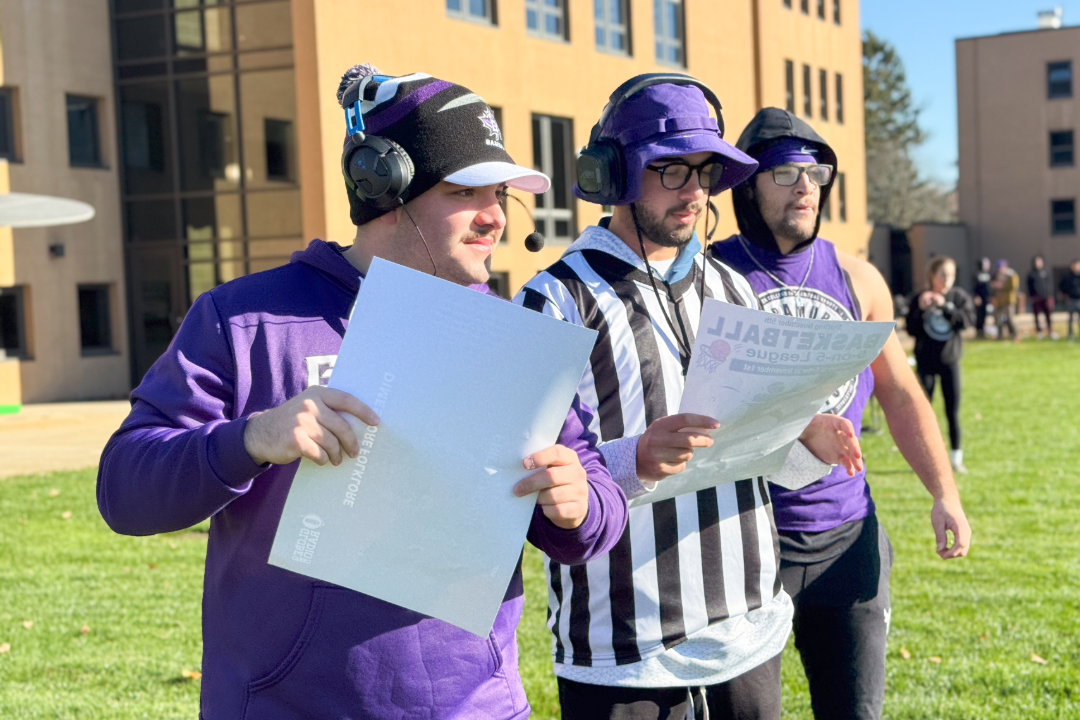Reporting by Liam Shaw and Eliza Alemán
At Goshen College, the spirit of friendly competition has long been part of student life. “I loved intramural sports, especially indoor volleyball,” said Ana Yoder ’25. “It gave me a reason to hang out with friends and meet people I wouldn’t normally cross paths with on campus. We got so competitive — it was so much fun.” Even before the school’s athletic programs were a part of it, students found ways to come together through intercollegiate games. From early tennis matches and baseball games in the 1910s to the fast-paced indoor volleyball and pickleball tournaments of today, intramural sports have provided a space for connection, fun and a little healthy rivalry. More than just a pastime, these games have shaped campus culture, offering students a chance to build friendships, explore leadership and celebrate both individual talent and collective effort.Intramural athletics at GC began modestly. By 1916, the college emphasized recreation as a place “where skill, brain and brawn are brought to a test” as said in the 1916 Maple Leaf. Tennis quickly emerged as the most popular sport, thanks to courts and the “co-athletic” nature of the game. Student competitions like class cups became a yearly tradition, with both men’s and women’s teams representing each class by 1919.
The early 1920s saw a push for better facilities. A new gymnasium was completed in 1922, sparking greater participation and enthusiasm for basketball and other indoor sports. Tennis remained the most popular sport, but basketball, baseball and track were also key parts of the program. By 1927, the college had invested in a large gymnasium with bleachers, showers and upgraded fields, making intramural sports more accessible and organized.
The late 1920s and 1930s marked a broadening of the intramural program. New sports like soccer, skiing and tobogganing began to gain popularity, while volleyball, badminton and archery were introduced in the 1930s. Archery, handball, tumbling and skating added variety, while touch football and softball in the late 1930s became instant hits. By 1949, women were actively participating in sports like field hockey, tumbling and volleyball.
The 1950s brought modern facilities like a combined auditorium-gymnasium, allowing “lesser” or indoor sports to flourish. pingpong, shuffleboard, horseshoes, badminton and tumbling became fixtures of student life. Winter sports, including skiing and ice skating, remained popular, making intramurals a year-round activity.
In 1956 GC added basketball as the first intercollegiate sport. Over the decades, the program continued to evolve, shifting with student interests and eventually growing into the modern mix of volleyball leagues, soccer tournaments, and the ever-popular pickleball matches seen on campus today. For many, these games continue to shape community life as much as they did a century ago. “Intramurals are an important part of campus culture because they bring people together and create an environment for positive interaction,” said Kevin Liddell ’25. Current and recent students echo that feeling. “I loved intramural volleyball—it gave me a reason to hang out with friends and meet people I wouldn’t normally cross paths with on campus,” said Ana Yoder ’25. Even the faculty got in on the action: “We played hard and talked a little trash, but in the end, the students showed us how it’s really done,” said Jodi Beyeler, vice president for institutional advancement, reflecting on her experience with pickleball.
Today, much of Goshen’s intramural life is shaped by Chad Coleman, who has overseen the program through several shifts in student culture and campus life. Coleman first took on intramurals in 2010, when institutional restructuring moved the program from Athletics into Student Life. At the time, he was a resident director with room in his schedule, so he agreed to step in and, as he put it, “I just never let it go.”
As GC prepares for another Turkey Bowl, the tradition continues to bring students together in the same way it has for generations “The Turkey Bowl is one of our most popular events. This is the 11th year we’ve done it,” Coleman said. For Coleman, that continuity is what keeps intramurals meaningful. “Intramurals were a huge part of my college experience. Whenever I get together with my college friends, we talk about intramurals every time.”




